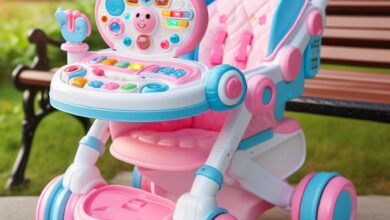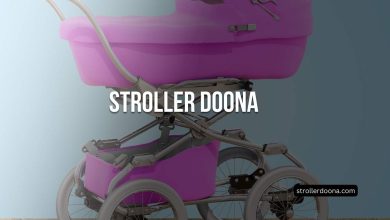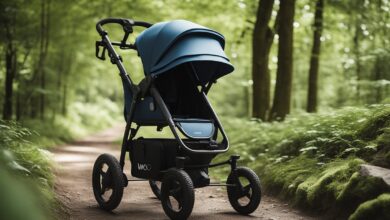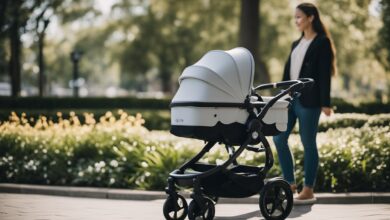Can You Take a Stroller on A Plane?
As parents, we all know that traveling with young children can be both exciting and challenging. One of the most common questions that arise when planning a family trip by air is, “Can you take a stroller on a plane?” The short answer is yes, but there’s much more to consider. This comprehensive guide will walk you through everything you need to know about bringing strollers on airplanes, helping you navigate the complexities of air travel with little ones in tow.
Whether you’re a first-time parent embarking on your inaugural family vacation or a seasoned traveler looking to streamline your journey, understanding the ins and outs of stroller policies can make a world of difference. From airline regulations to practical tips for a smooth airport experience, we’ll cover it all. So fasten your seatbelts (and stroller straps) as we take off into the world of air travel with strollers!
The Basics: Yes, You Can Bring a Stroller on a Plane
Let’s start with the fundamental question: Can you take a stroller on a plane? The resounding answer is yes. Airlines generally allow passengers to bring strollers when traveling with young children. However, the specifics can vary depending on the airline, the type of stroller, and even your destination.
Airline Policies on Strollers
While most airlines permit strollers, it’s crucial to understand that policies can differ. Here’s a general overview of how major airlines handle strollers:
- Checked Strollers: Many airlines allow you to check your stroller at the ticket counter for free, in addition to your regular checked baggage allowance.
- Gate-Check Options: Most airlines offer the convenience of gate-checking your stroller. This means you can use it throughout the airport and check it at the boarding gate just before entering the plane.
- Cabin Storage: Some airlines may allow small, collapsible strollers to be stored in the overhead bin, subject to available space.
- Size and Weight Restrictions: Airlines often have specific size and weight limits for strollers. Exceeding these limits may result in additional fees or the need to check the stroller as regular baggage.
To illustrate the variations in airline policies, let’s look at a comparison table of some major carriers:
| Airline | Stroller Policy |
|---|---|
| American Airlines | One stroller and one car seat may be checked free of charge. Strollers over 20 lbs must be checked at the ticket counter. |
| Delta Air Lines | One stroller and one car seat can be checked for free. Strollers can be checked at the ticket counter or gate. |
| United Airlines | All strollers can be checked for free. Small, collapsible strollers may be brought onboard, subject to space availability. |
| Southwest Airlines | Strollers can be checked for free at the ticket counter or gate. |
| British Airways | Allows a fully collapsible stroller plus one car seat per child, free of charge. |
It’s important to note that these policies can change, so always check with your specific airline before traveling.
Types of Strollers and Air Travel Compatibility
Not all strollers are created equal when it comes to air travel. Understanding which types are best suited for flying can help you make informed decisions when purchasing a travel stroller or deciding which one to bring on your trip.
Best Strollers for Air Travel
- Umbrella Strollers: These lightweight, compact strollers are often the go-to choice for air travel. They’re easy to fold, typically weigh less than 15 pounds, and can often fit in overhead bins.
- Travel Systems: While bulkier, travel systems that include a car seat can be convenient for seamless transitions from car to plane to destination.
- Convertible Strollers: Some convertible strollers can transform into a compact travel stroller, offering versatility for both daily use and travel.
- Jogging Strollers: Although not ideal for air travel due to their size and weight, some parents prefer these for their durability. If you choose to bring one, be prepared to gate-check it.
Features to Look for in a Travel-Friendly Stroller
When selecting a stroller for air travel, consider these features:
- Lightweight: Aim for a stroller under 15 pounds to ease airport navigation.
- Compact Fold: A stroller that folds easily and becomes very compact is ideal for storage.
- Durability: Look for sturdy construction to withstand the rigors of travel.
- Travel Bag: Some strollers come with a travel bag, which can protect them during transit.
- Easy Maneuverability: Smooth-rolling wheels and good steering make airport navigation easier.
Navigating the Airport with a Stroller
Bringing a stroller to the airport can be a double-edged sword. On one hand, it provides a convenient way to transport your child and your belongings. On the other, it can add complexity to your journey through security and to the gate. Here’s how to make the most of your stroller at the airport:
Security Checkpoint Procedures
- Prepare in Advance: Before reaching security, remove any items from the stroller’s storage areas.
- Folding Requirements: Most airports require strollers to be folded and placed on the X-ray belt. Some may allow you to push the stroller through a separate scanner.
- Child Handling: If your child is sleeping, inform the TSA agent. They may allow a modified screening process.
- Liquid Rules: Remember that baby food, milk, and formula are exempt from the 3-1-1 liquids rule, but inform the agents if you’re carrying these items.
According to the Transportation Security Administration (TSA), in 2019, approximately 2.7 million children under 18 traveled through U.S. airports daily. This statistic underscores the importance of efficient stroller management in airports.
Tips for Easy Airport Navigation
- Use a Backpack Diaper Bag: This leaves your hands free to manage the stroller.
- Attach a Luggage Tag: Label your stroller with your contact information in case it gets misplaced.
- Practice Folding: Become proficient at quickly folding and unfolding your stroller before your trip.
- Consider a Stroller Hook: These handy accessories allow you to hang bags on your stroller, freeing up storage space.
- Arrive Early: Give yourself extra time to navigate security and boarding with a stroller.
Boarding the Plane with a Stroller
The boarding process can be one of the most stressful parts of air travel with a stroller. Here’s what you need to know:
Gate-Checking Procedures
- Obtain a Tag: At the gate, ask for a gate-check tag for your stroller.
- Timing: Most airlines allow you to keep your stroller until you board the plane.
- Folding: Fold the stroller before boarding and have it ready to hand over to the gate agent or place it in the jet bridge.
- Retrieval: Upon arrival, your stroller will typically be waiting for you in the jet bridge or at baggage claim.
Carrying On Small Strollers
If your stroller is small enough to fit in the overhead bin:
- Check Size Limits: Confirm with the airline that your stroller meets carry-on size restrictions.
- Boarding Order: Take advantage of pre-boarding options for families to ensure overhead space.
- Quick Storage: Be prepared to quickly stow your stroller to avoid delaying other passengers.
In-Flight Considerations
Once you’re on the plane, your focus shifts to keeping your child comfortable and entertained. While your stroller is stowed away, consider these in-flight tips:
- Comfort Items: Bring familiar items from home to soothe your child.
- Entertainment: Pack age-appropriate toys, books, and electronic devices.
- Snacks: Bring plenty of snacks to keep hunger at bay and provide a distraction.
- Pressure Changes: For infants, consider feeding during takeoff and landing to help equalize ear pressure.
- Diaper Changes: Be prepared with easily accessible diapering supplies for in-flight changes.
Retrieving Your Stroller at Your Destination
After landing, the process of reuniting with your stroller begins. Here’s what to expect:
Gate-Checked Strollers
- Immediate Retrieval: In many cases, gate-checked strollers are brought to the jet bridge upon arrival.
- Patience Required: There may be a short wait as ground crew bring up strollers.
- Inspection: Quickly check your stroller for any damage before leaving the gate area.
Baggage Claim Pickup
If your stroller was checked at the ticket counter:
- Oversize Baggage: Large strollers may come out at the oversize baggage area rather than the regular carousel.
- Damage Claims: If you notice any damage, report it to the airline immediately before leaving the airport.
According to the U.S. Department of Transportation, in 2019, airlines reported 2.8 mishandled bags per 1,000 passengers. While this rate includes all checked items, it underscores the importance of properly tagging and identifying your stroller.
International Travel Considerations
When traveling internationally with a stroller, additional factors come into play:
- Customs Regulations: Some countries may have specific rules about bringing baby equipment into the country.
- Voltage Differences: If your stroller has any electronic components, be aware of voltage differences in other countries.
- Local Terrain: Research your destination to ensure your stroller is suitable for local conditions (cobblestone streets, sandy beaches, etc.).
- Rental Options: In some cases, it might be more convenient to rent a stroller at your destination.
Stroller Alternatives for Air Travel
While strollers are incredibly useful, some parents opt for alternatives, especially for older toddlers:
- Baby Carriers: Wearable carriers keep your hands free and eliminate the need for a stroller.
- Travel Harnesses: These devices attach to rolling carry-on luggage, allowing toddlers to ride along.
- Portable Booster Seats: For dining out at your destination without the bulk of a high chair.
- Lightweight Travel Wagons: Collapsible wagons can serve as a stroller alternative and double as beach or park gear.
Maintenance and Care for Travel Strollers
Frequent travel can take a toll on your stroller. Here are some tips for keeping it in top condition:
- Regular Cleaning: Wipe down your stroller after each trip to prevent dirt buildup.
- Lubrication: Keep wheels and folding mechanisms well-lubricated for smooth operation.
- Protective Covers: Use a travel bag or cover to protect your stroller when checking it.
- Spare Parts: Carry small spare parts like screws or pins in case of minor repairs needed on the go.
- Professional Service: Consider having your stroller professionally serviced annually if you travel frequently.
The Future of Strollers and Air Travel
As air travel evolves, so do the products and policies surrounding traveling with children. Some emerging trends include:
- Smart Strollers: Strollers with built-in GPS tracking and even motorized assistance are entering the market.
- Eco-Friendly Materials: More manufacturers are using sustainable materials in stroller construction.
- Improved Airline Policies: Some airlines are exploring ways to make family travel smoother, including dedicated family lanes and improved stroller handling.
- Innovative Designs: Expect to see more ultra-compact, travel-specific stroller designs in the future.
FAQ: Common Questions About Taking Strollers on Planes
Q: Do I have to pay extra to bring a stroller on a plane?
A: Generally, no. Most airlines allow you to check a stroller for free, in addition to your regular baggage allowance.
Q: Can I use my stroller in the airport?
A: Yes, you can typically use your stroller throughout the airport until you board the plane.
Q: What’s the difference between gate-checking and regular checking for strollers?
A: Gate-checking allows you to use the stroller until you board the plane, while regular checking requires you to leave it at the ticket counter.
Q: Are there size restrictions for strollers on planes?
A: Yes, most airlines have size restrictions. Check with your specific airline for details.
Q: Can I bring both a stroller and a car seat on the plane?
A: Usually, yes. Most airlines allow both a stroller and a car seat to be checked for free.
Q: What should I do if my stroller is damaged during the flight?
A: Report any damage to the airline immediately upon arrival, before leaving the airport.
Q: Can I bring a jogging stroller on a plane?
A: Yes, but due to their size, jogging strollers usually need to be checked at the ticket counter or gate.
Q: Is it better to gate-check or regularly check my stroller?
A: Gate-checking is often more convenient as you can use the stroller in the airport, and it may receive gentler handling.
Q: Can I bring a stroller and a baby carrier?
A: Yes, you can typically bring both. The carrier can be especially useful on the plane.
Q: Are there any strollers designed specifically for air travel?
A: Yes, many brands offer compact, lightweight strollers designed with air travel in mind.
Conclusion
Navigating air travel with a stroller doesn’t have to be a daunting task. With the right preparation, knowledge, and equipment, you can make your family journey smoother and more enjoyable. Remember that policies can vary between airlines and even change over time, so always double-check with your carrier before traveling.
The key takeaways from this guide are:
- Most airlines allow strollers to be checked for free, either at the ticket counter or the gate
- Lightweight, compact strollers are ideal for air travel
- Preparation is crucial, from navigating security to boarding the plane
- Consider your specific travel needs when choosing between using a stroller or alternatives like baby carriers
As you embark on your travels, keep in mind that millions of families successfully navigate airports with strollers every year. With patience, flexibility, and the tips provided in this guide, you’ll be well-equipped to join their ranks and create lasting memories with your little ones.
Whether you’re jetting off to a tropical paradise, visiting relatives across the country, or embarking on an international adventure, your stroller can be a valuable travel companion. By understanding the rules, preparing adequately, and choosing the right equipment, you can focus on what really matters – enjoying your family vacation to the fullest.




